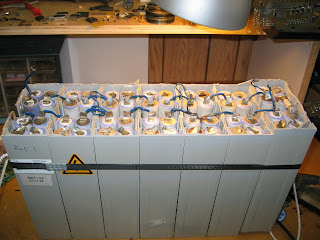
Last night I decided to start testing my lithium batteries in preparation of building a battery pack for the Twike. I have a RC Electronics Watts Up Meter and a West Mountain Radio Computerized Battery Analyzer. I previously found a way to purchase A123 M1 cells (new) in dewalt packs for $6.50/cell so I have 120 cells to build my first pack. I'm going to go with 112 batteries per pack in series (112s1p) to best match the voltage requirements of the Twike, and then parallel multiple packs to get range. The old setup with NiCad batteries was 280 cells in series. That gave a lower voltage cutoff of 280 volts (1.0v/cell) and a upper charge limit of 420 volts (1.5 * 280). In my case, the A123 cells wants a upper charge limit of 3.64 volts so my 112 cells will need to reach 408 volts to fully charge. The low voltage cutoff for a A123 cells is 2.5 volts so this works out to 280 (which happens to match NiCad). So, that is my design target. I took apart my first pack of 8 cells using a T10 security bit (get a long skinny one or drill part of the case). I clipped off the two black wires and one red wire to the internal BMS which I am not going to use. After disconnecting the per cell balancing connectors, I could extract the cells. I had charged them once on the standard Dewalt charger so I knew the cells were all reasonably ok. It will detect and fail to charge a pack if any cell is below 2.5 volts (a possibly harmful condition for a cell if that way for long). A quick check with a meter showed them all pretty close in voltage. I did a 3 amp discharge down to 20 volts (2.5 * 8) to measure cell capacity and see if I had any bad cells. Came out to 2.1 Ah (and 52.8 Wh) which is fine given I did not have it on the charger for several weeks. Both CBA and the Watts UP meter gave the same numbers for Ah and Wh delivered from the pack. I then measured each cells voltage and found them pretty close. No need to do more balancing. I then used a regulated supply to charge the pack back up to 29.12 volts (8 * 3.64) at 3 amps. Took 58.4 Wh (2.156 Ah) to charge it back up. Looks good to me. Now on to pack and BMS design and purchasing more lithium packs. NOTE: I figure the Twike uses about 80Wh/mile so that one pack of 112 cells gives me about 10 mile range (and weights about 17 lbs). I'd like to get to 40 miles range to cover 98 % of my daily trips so I can use it to commute daily to work so I'm looking at building 4 packs (with 448 cells).






